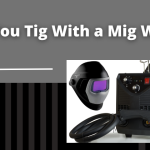This highly precise and versatile welding method is called Gas Tungsten Arc Welding (GTAW). This article will explore the top 10 benefits of using a TIG welder for your welding projects. From its ability to produce high-quality welds on a wide range of materials to its increased efficiency and versatility, a TIG welder can greatly improve the quality and speed of your welding work. Whether you are a professional welder or a DIY enthusiast, understanding the benefits of TIG welding can help you make informed decisions about the tools and techniques you use for your projects.

Top 10 Benefits of Using a Tig Welder
High Precision Welding
One of the main benefits of TIG welding is the ability to achieve high precision in the welding process. The tungsten electrode and an inert gas (usually argon) provide precise control over the heat input and the arc, creating clean, visually appealing welds. TIG welding is often used in applications where the appearance of the weld is important, such as in the automotive and aerospace industries.
Greater Control Over Heat Input
In addition to its precision, TIG welding also allows for greater control over the heat input in the welding process. This is important because different materials and metal thicknesses require different amounts of heat to be welded properly. TIG welders allow the welder to adjust the heat input as needed, which helps prevent warping and other distortions in the workpiece.
Wide Range of Materials
TIG welders can be used on various materials, including aluminum, stainless steel, and copper alloys. This versatility makes TIG welding a good choice for many projects and industries.
No Spatter
TIG welding produces minimal spatter, the small droplets of molten metal expelled during the welding process. Spatter can make a mess and contaminate the weld, reducing its strength and durability. TIG welding produces little to no spatter, making it easier to clean up and reducing the risk of contamination.
Greater Strength and Durability
TIG welds are known for their strength and durability, making them suitable for high-stress applications. TIG welds can withstand high levels of strain and are less prone to cracking or failure than other welding methods.
Less Distortion
TIG welding also produces less distortion in the workpiece than other welding methods, making it easier to achieve precise tolerances. This is especially important in industries where precision is critical, such as in the aerospace and medical fields.
Longer Welding Times
TIG welders can be used for longer periods without requiring frequent breaks to change electrodes or consumables. This can increase productivity and efficiency in a manufacturing setting.
Increased Productivity
The precision and control provided by TIG welders can also increase overall productivity in a manufacturing setting. TIG welders can produce high-quality welds faster and with less rework, saving time and money in the long run.
Versatility
TIG welders can be used in various industrial, automotive, and aerospace applications. This versatility makes them a valuable tool for many different projects and industries.
FAQ’s
What Is The Main Benefit Of Tig Welding?
The main benefit of TIG welding is the ability to produce precise and clean welds with high integrity. TIG welding is suitable for a wide range of materials and thicknesses, and it can be used in various positions. It is also a fast process that requires minimal post-weld cleaning and produces minimal fumes and spatter, making it a safe and efficient option for businesses.
What Are The 11 Steps Of Tig Welding?
The 11 steps of TIG welding are as follows:
- Set up the TIG welding equipment, including the power source, torch, and filler material.
- Choose the appropriate tungsten electrode size and shape for the material and application.
- Select the proper torch angle for the welding position.
- Secure the workpiece in place.
- Clean the workpiece and remove any contaminants or oxide layers.
- Assemble the TIG torch and connect the shielding gas.
- Strike an arc by touching the tungsten electrode to the workpiece and pulling it away.
- Maintain the arc by using the foot pedal to control the current.
- Add filler material as needed to build up the weld bead.
- Keep the torch moving in a steady, controlled motion.
- End the weld by releasing the foot pedal and breaking the arc.
What Is Unique About Tig Welding?
TIG welding is unique because it uses a non-consumable tungsten electrode to produce the weld. This allows for precise control of the heat input and the filler material, resulting in clean and visually appealing welds. TIG welding is also versatile and can be used on a variety of materials and thicknesses, and it can be performed in various positions.
What Are The 4 Main Functions Of A Tig Welding Torch?
The 4 main functions of a TIG welding torch are:
- Generating and maintaining the arc
- Supplying shielding gas to protect the weld from contamination
- Providing a means to add filler material to the weld
- Cooling the torch and protecting the welder from the heat of the arc.
What Are The 9 Different Types Of Welding Processes?
There are several welding processes, each with unique characteristics and advantages. Here is a list of 9 common welding processes:
- Shielded Metal Arc Welding (SMAW): Also known as stick welding, this process uses an electric arc to melt and fuse metal. It is a versatile process that can be used on various materials and is relatively easy to learn.
- Flux-Cored Arc Welding (FCAW): Similar to SMAW, this process uses an electric arc and a flux-cored wire to melt and fuse metal. It is faster than SMAW and can be used in out-of-position welding.
- MIG Welding (GMAW): Also known as wire welding, this process uses a wire electrode fed through a welding gun and an electric arc to melt and fuse metal. It is a fast and efficient process that is easy to learn and is commonly used in the automotive and construction industries.
- TIG Welding (GTAW): TIG welding uses a non-consumable tungsten electrode and a separate filler rod to produce the weld. It is a precise process often used for thin materials and is known for producing high-quality, aesthetically pleasing welds.
- Plasma Arc Welding (PAW): This process uses a plasma torch to produce the weld and is often used for thin materials or materials with high melting points. It is a precise and efficient process that produces high-quality welds.
- Submerged Arc Welding (SAW): This process uses a consumable electrode covered with flux and submerged in a pool of molten weld metal. It is a high-production process commonly used in the construction and manufacturing industries.
- Gas Metal Arc Welding (GMAW-P): Also known as pulse MIG welding, this process uses a MIG welding machine with a pulsing current to produce the weld. It is a precise and efficient process often used for thin materials.
- Resistance Welding: This process uses electrical resistance to generate heat and melt the metal, resulting in a weld. There are several types of resistance welding, including spot welding and seam welding.
- Laser Beam Welding (LBW): This process uses a high-energy laser beam to melt and fuse the metal, producing a precise and efficient weld. It is often used for thin materials or materials with high melting points.
Each welding process has unique characteristics and advantages, and the best process for a given application will depend on the materials being welded and the desired result.
Why Is Tig Welding Better Than Mig?
TIG (Tungsten Inert Gas) welding is often considered to be a more precise and versatile welding method compared to MIG (Metal Inert Gas) welding. TIG welding uses a non-consumable tungsten electrode to produce an electric arc. It heats the metal being welded, while MIG welding uses a consumable wire electrode continuously fed through the welding torch.
One of the main advantages of TIG welding is the ability to achieve high precision in the welding process. The tungsten electrode and an inert gas (usually argon) provide precise control over the heat input and the arc, creating clean, visually appealing welds. TIG welding is often used in applications where the appearance of the weld is important, such as in the automotive and aerospace industries.
In addition to its precision, TIG welding also allows for greater control over the heat input in the welding process. This is important because different materials and metal thicknesses require different amounts of heat to be welded properly. TIG welders allow the welder to adjust the heat input as needed, which helps prevent warping and other distortions in the workpiece.
TIG welds are also known for their strength and durability, making them suitable for high-stress applications. TIG welds can withstand high levels of strain and are less prone to cracking or failure than other welding methods.
TIG welders can be used on various materials, including aluminum, stainless steel, and copper alloys. This versatility makes TIG welding a good choice for many projects and industries.
On the other hand, MIG welding is generally faster and easier to learn than TIG welding, but it could be more precise and versatile. MIG welds are less visually appealing than TIG welds and are unsuitable for applications where appearance is important. MIG welds are also less durable and more prone to cracking and other failures than TIG welds.
Overall, TIG welding offers many advantages over MIG welding, including precision, control, strength, and versatility. However, MIG welding is still a useful method and may be a better choice in certain situations, such as when speed and ease of use are more important than precision and appearance.
Conclusion
TIG welding offers numerous benefits for a wide range of applications and industries. Its precision, control, and versatility make it an attractive option for many welding projects.
In summary, TIG welding offers numerous benefits for various applications and industries. Its precision, control, and versatility make it an attractive option for many welding projects. Whether working on a small repair job or a large manufacturing project, TIG welding can provide the high-quality, durable welds you need.

It’s been years since I got into welding as a side hustle. It’s been so long since Doing All kinds of welds for business and pleasure as this is my hobby. Being in this field I have learned from hands-on-experience also came to know what gears work and what doesn’t. The Tig Welder is my own platform where I use to share my experience.





Leave a Reply